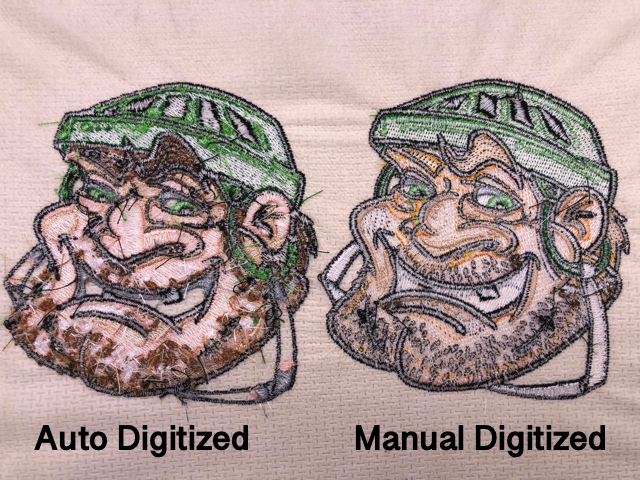Grasping the Needlework Digitizing Process: Your Ultimate Overview
Embroidery digitizing is a thorough craft that calls for precision and expertise to translate detailed layouts into electronic styles for device embroidery. As craftsmens begin on this journey to understand the embroidery digitizing procedure, a thorough understanding of the fundamentals establishes the foundation for excellence.

Recognizing Needlework Digitizing Essentials
Needlework digitizing essentials create the structure whereupon intricate designs are translated right into machine-readable layouts for specific sewing. This first action in the needlework digitizing procedure is vital for making certain that the last embroidered product is a devoted representation of the original layout. Recognizing needlework digitizing essentials includes comprehending crucial ideas such as stitch types, stitch direction, thickness, rug, and pull payment.
Stitch types play a vital duty in establishing the aesthetic and textural result of the stitched design. By selecting the appropriate stitch type, whether it be satin, fill, or running stitch, digitizers can achieve the preferred impact and improve the general high quality of the embroidery. Additionally, stitch instructions affects the flow and dimension of the design, while density identifies the spacing and coverage of the stitches.
Furthermore, padding stitching provides security to the style by securing the textile and protecting against distortion during the embroidery procedure. Pull settlement is one more vital consideration to combat the all-natural propensity of fabric to contract when sewn. Mastering these needlework digitizing basics is essential for creating professional-quality embroidered products.
Choosing the Right Digitizing Software
Selecting the proper digitizing software application is a critical decision that significantly impacts the effectiveness and high quality of the needlework digitizing procedure. Digitizing for Embroidery. When selecting the appropriate digitizing software program, it is necessary to take into consideration aspects such as the complexity of designs you intend to develop, the user-friendliness of the software program, the degree of client assistance used, and the compatibility with your embroidery equipment
There are various digitizing software program choices available in the marketplace, varying from fundamental programs for beginners to innovative software application for specialist digitizers. Some popular choices consist of Wilcom EmbroideryStudio, Hatch Needlework Software, and PulseID. These software application bundles provide a variety of tools and attributes to assist you produce complex layouts with ease.
Before choosing, it is advisable to check out the various software program choices via totally free trials or demos to establish which one best fits your demands. In addition, checking out testimonials and looking for suggestions from skilled digitizers can give valuable understandings right into the toughness and weaknesses of each software (Digitizing for Embroidery). By very carefully reviewing your needs and contrasting the functions of various digitizing software program, you can make an educated selection that improves your embroidery digitizing operations
Digitizing Tools and Strategies

Optimizing Layout Setup for Needlework
Understanding the why not look here intricacies of style setups is essential in attaining ideal results in the needlework digitizing procedure, building upon the foundation laid by comprehending digitizing devices and strategies. When enhancing style settings for embroidery, it is vital to think about elements such as stitch type, density, underlay, pull settlement, and enrollment. Registration settings straighten various aspects here of the style properly, preserving total style honesty.

Troubleshooting Common Digitizing Issues
When encountering typical digitizing issues during the embroidery procedure, it is vital to comprehend the source and apply effective solutions immediately. One common trouble is stitch density problems, where stitches may be too thick, triggering the textile to pucker, or as well sparse, resulting in spaces in the layout. Readjusting the stitch thickness settings in the digitizing software can aid settle this concern.
One more regular obstacle is thread breaks throughout the embroidery process. This can take place because of various reasons such as incorrect stress setups, plain needles, or using low-quality thread. Making certain correct maintenance of the embroidery device, including normal needle adjustments and tension adjustments, can reduce the incident of string breaks.
Furthermore, layout registration errors can result in misaligned components within the needlework layout. Checking the layout alignment in the digitizing software program and making essential adjustments prior to sewing can assist in avoiding this issue. By dealing with these common digitizing concerns promptly and effectively, you can make certain a smoother needlework procedure and premium ended up items.
Final Thought
In conclusion, grasping the embroidery digitizing procedure needs a strong understanding of the fundamentals, the best selection of software application, and knowledge of tools and strategies. Optimizing layout settings and repairing typical digitizing problems are essential steps in ensuring top notch embroidery results. By following these steps faithfully, one can achieve accuracy and performance in the digitizing check procedure.